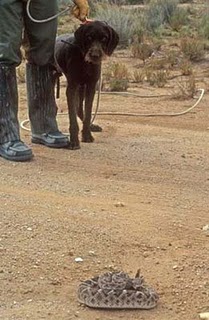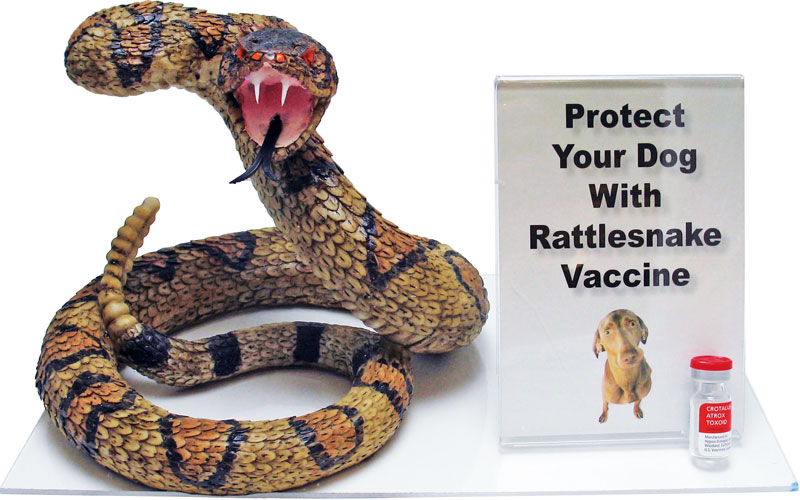Snake Aversion Therapy
Share

 Spring is in the air and with this beautiful season follows the arrival of rattlesnakes. If you live in the US, you’ve probably had at least one experience with snakes, and if you live in the Southwest, you’ve probably had a few.
Spring is in the air and with this beautiful season follows the arrival of rattlesnakes. If you live in the US, you’ve probably had at least one experience with snakes, and if you live in the Southwest, you’ve probably had a few.
Approximately 300,000 dogs and cats are bitten by venomous snakes each year in the United States. But, between leashes, Snake-Training Your Dogs, vaccinating for snake bites, and prompt medical care – we are helping dogs survive these bites.
Here’s the low down on snakebites.
If you’re out hiking with your dog and stumble across a rattler, what is the best course of action? First off, you should have your dog on a leash at all times – even while on a trailhead. This will help, but oftentimes, it won’t be enough.
Snakes have a tendency to lie across the trail or out in the open where they can absorb the heat from the sun. They can be difficult to see if you’re not paying attention, so try to always pay attention to where you’re walking and what your dog is sniffing.
[heading style=”1″ color=”#996633″ style_color=”#996633″] Don’t Try to Kill the Snake[/heading]If you’re dog attacks or doesn’t see it in time, and is struck by the snake, try not to panic. Many snake bites are “dry” bites, meaning they have not injected poison. Snakes don’t want to waste their toxins on anything they can’t eat and many bites are not fatal. (But, always treat a snakebite as if it is).
If you or your pet is bitten, do not waste time trying to “kill the snake” to bring it back and show the vet. The brain of a snake can remain active long after its head is removed.
Due to its unique anatomy, the decapitated head of a snake can still kill you.
Never mess with a snake – whether you think it’s dead or alive.
[heading style=”1″ color=”#996633″ style_color=”#996633″]Get To Veterinarian Immediately (even if your pets been vaccinated)[/heading]
If you’re hiking or out in the desert, get out of there immediately, and if possible, carry your dog out even if your dog has been vaccinated (you can learn more about the rattlesnake vaccine in Keeping Pets Safe from Rattlesnakes).
Don’t waste time trying to kill the snake, waiting for a reaction in your pet, or trying to take a picture of the snake. Your veterinarian will be able to determine the type of snake your pet was bitten by, but if you did see the snake, try to remember the color, shape, patterns, and noise it made.
Many snakes have learned not to rattle, and really, that’s never the best way to judge if a snake is dangerous. Just because you didn’t hear a rattle doesn’t mean your pet didn’t find a rattler.
Snakes use the rattle as a warning, but the more we kill snakes and the more we ignore their warnings, the more a rattler will not bother to rattle at all.
Stay calm.
Adrenaline will increase heart rate, which will increase the spread of poison. Chances are good that your dog was struck in the throat, and if that’s the case, you need to ensure he or she can breathe. The poison will cause intense swelling, which can close off your dog’s airway. Get him or her to the vet as soon as humanly possible. Do not stop and try to suck out the poison (it doesn’t work and can end up killing you). Just get to a vet.
[heading style=”1″ color=”#996633″ style_color=”#996633″]Vaccinate Your Pet – Rattlesnake Vaccine for Dogs and Horses[/heading]
 If you’re in an area where snakes are rampant, you need to make sure your pet is vaccinated. Crotalus Atrox Toxoid (rattlesnake vaccine for dogs) was developed specifically to provide protection for dogs and horses against Western Diamondback Rattlesnake venom. However, since venom from other types of snakes are similar to the venom of the Western Diamondback Rattlesnake, this vaccine may also provide protection against them, and they include:
If you’re in an area where snakes are rampant, you need to make sure your pet is vaccinated. Crotalus Atrox Toxoid (rattlesnake vaccine for dogs) was developed specifically to provide protection for dogs and horses against Western Diamondback Rattlesnake venom. However, since venom from other types of snakes are similar to the venom of the Western Diamondback Rattlesnake, this vaccine may also provide protection against them, and they include:
- Western Rattlesnake (including the Prairie, Great Basin, Northern and Southern Pacific varieties)
- Sidewinder
- Timber Rattlesnake
- Massasauga
- Copperhead
- Partial protection may be obtained against Eastern Diamondback Rattlesnake venom.
- NOTE: This vaccine does not provide protection against venom from the Water Moccasin (Cottonmouth), Mojave Rattlesnake or Coral Snake.
Please remember that just because your dog has been vaccinated, does not mean your dog will not react to a bite. The goal of this vaccine is to provide protective antibodies by neutralizing rattlesnake venom. Dogs with protective antibodies are reported to experience less pain and have a reduced risk of permanent injury from rattlesnake bite. Veterinarians typically report that vaccinated dogs bitten by rattlesnakes experience less swelling, less tissue damage and a faster recovery from snakebite than unvaccinated dogs. You still need to ensure your pets are taken to a vet immediately.
If you choose to have your dog or horse vaccinated, you will need to have an initial vaccination, followed by a booster vaccine six months later. At this time, they recommend vaccinating for snakes annually. Since the vaccine needs time to react in your dog’s body, you should plan to give the first set about 4-6 weeks prior to rattlesnake season. If your dog is at particular risk of being bitten by a rattlesnake (for example, a search and rescue dog, some hunting dogs or dogs living in a high density rattlesnake area where rattlesnakes are active year-round), you and your veterinarian may wish to consider using three booster doses per year at four-month intervals.
[heading style=”1″ color=”#996633″ style_color=”#996633″]Training Your Pet[/heading]
Of course, the best thing to do is teach your dog to avoid snakes altogether. This can be done through a series of snake aversion training by a certified trainer.
There are many ways to train a dog to avoid snakes, but aversion therapy is one of the best I’ve seen. Yes, it uses static electricity collars. Yes, it’s difficult to watch. Yes, it will likely save your dog’s life in the long run. The good thing is that it only needs to be done once in a dog’s life (in most cases). It’s a lesson they’ll remember for the rest of their lives.
A good trainer will teach dogs to avoid snakes using sight, sound and smell. Ensure that the trainer you use has a long line of references and positive feedback from previous clients. They will lead your dog through a “rattlesnake” course, using snakes that have been rescued from the backyards of terrified homeowners. The snakes should later be released into the wild – ensure you find a humane trainer who handles the snakes humanely and with a minimum amount of aversion.
Snake aversion therapy is the only time I would recommend the use of aversion training. It’s THAT important for the dog to associate a strong reaction with seeing or hearing or smelling a snake.
If you’re interested in taking your dog in for “snake aversion” therapy, check your local listings for a qualified, accomplished trainer who offers humane methods of training. Ensure that they treat the “volunteer snakes” well, and you’ll be in good shape. In Arizona, the most well-known group is called Partners Dog Training offers snake avoidance training.
It might just save your dog’s life….
[box title=”Other Important Information” box_color=”#996633″ radius=”13″]ASPCA Poison Control Hotline
1-888-426-4435
Note: There is a $60 charge for this service.
The National Animal Poison Control Center (NAPPC)
1-800-548-2423
1-900-680-0000
Note: If you call the 1-900 number, the charge is $20.00 for the first five minutes, then $2.95/minute thereafter. If you use the 800 number, the charge is $30.00 per case.










